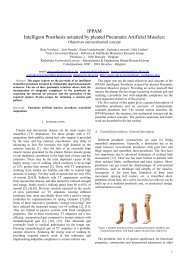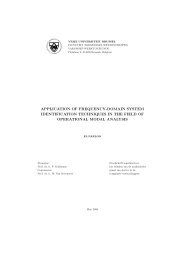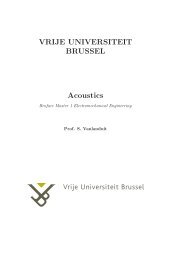MODAL ANALYSIS - the Dept. of Mechanical Engineering at - Vrije ...
MODAL ANALYSIS - the Dept. of Mechanical Engineering at - Vrije ...
MODAL ANALYSIS - the Dept. of Mechanical Engineering at - Vrije ...
Create successful ePaper yourself
Turn your PDF publications into a flip-book with our unique Google optimized e-Paper software.
(a) (b)<br />
Figure 2: Wind tunnel tests on a scaled model <strong>of</strong> (a) a Cessna and (b) an Airbus A380.<br />
The majority <strong>of</strong> structures can be made to reson<strong>at</strong>e, i.e. to vibr<strong>at</strong>e with excessive oscill<strong>at</strong>ory motion.<br />
Resonant vibr<strong>at</strong>ion is mainly caused by an interaction between <strong>the</strong> inertial and elastic properties <strong>of</strong><br />
<strong>the</strong> m<strong>at</strong>erials within a structure. Resonance is <strong>of</strong>ten <strong>the</strong> cause <strong>of</strong>, or <strong>at</strong> least a contributing factor to<br />
many <strong>of</strong> <strong>the</strong> vibr<strong>at</strong>ion and noise rel<strong>at</strong>ed problems th<strong>at</strong> occur in structures and oper<strong>at</strong>ing machinery.<br />
To better understand any structural vibr<strong>at</strong>ion problem, <strong>the</strong> resonant frequencies <strong>of</strong> a structure need<br />
to be identified and quantified. Today, modal analysis has become a widespread means <strong>of</strong> finding<br />
<strong>the</strong> modes <strong>of</strong> vibr<strong>at</strong>ion <strong>of</strong> a machine or structure (Figure 3). In every development <strong>of</strong> a new or<br />
improved mechanical product, structural dynamics testing on product prototypes is used to assess its<br />
real dynamic behavior.<br />
2. The “Modal” Model<br />
Figure 3: Modal analysis <strong>of</strong> a car body.<br />
Modes are inherent properties <strong>of</strong> a structure, and are determined by <strong>the</strong> m<strong>at</strong>erial properties (mass,<br />
damping, and stiffness), and boundary conditions <strong>of</strong> <strong>the</strong> structure. Each mode is defined by a n<strong>at</strong>ural<br />
(modal or resonant) frequency, modal damping, and a mode shape (i.e. <strong>the</strong> so-called “modal<br />
parameters”). If ei<strong>the</strong>r <strong>the</strong> m<strong>at</strong>erial properties or <strong>the</strong> boundary conditions <strong>of</strong> a structure change, its<br />
modes will change. For instance, if mass is added to a structure, it will vibr<strong>at</strong>e differently. To<br />
understand this, we will make use <strong>of</strong> <strong>the</strong> concept <strong>of</strong> single and multiple-degree-<strong>of</strong>-freedom systems.

















